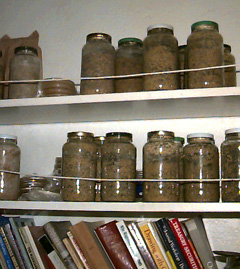
Click the link, or scroll down the page.

With peroxide, you can prepare sawdust cultures without pressure sterilizing either the bulk substrate or the supplements. You can even do it without heating the substrate. To do this, you will need to use peroxide-compatible starting materials such as wood pellet fuel and selected nitrogen supplements. Volume I of the peroxide manual describes a simple pellet fuel procedure with a boiling-water pasteurization, and it gives the details on how to select appropriate materials and supplements. Volume II of the manual presents an "add-and-stir" protocol for preparing peroxide-compatible porous substrates such as pellet fuel, paper fiber pellets, and kiln-dried sawdust, using peroxide at room temperature.
Peroxide can do away with costly filter-patch culture bags for bulk substrate. Grow cultures in ordinary trashbags (placed inside boxes) right out of the package, or in reusable plastic buckets with lids.
Added peroxide keeps cultures from going anaerobic (breakdown of the added peroxide by the mushroom mycelium releases oxygen). This makes it possible to pack sawdust-based substrate more tightly, creating a denser substrate favored by many species.
Peroxide kills mushroom spores, so you can grow agar cultures in the same building you use to fruit your mushrooms, even if the mushrooms produce a high spore load.
Peroxide kills contaminants without encouraging new resistant strains. (Antibiotics, sometimes added to agar medium, kill only bacteria, and can select for antibiotic resistant mutants).
Hydrogen peroxide in 3% solution is inexpensive, odorless, non-volatile, non-allergenic, low toxicity, non-irritating, stable, readily available, easy to handle, mechanically dispensable, entirely biodegradable, and environmentally benign.
Because of their enzyme content, most soft-textured raw nitrogen supplements (such as bran, cornmeal, cottonseed meal, etc.) still need to be baked or pressure sterilized before adding them to peroxide-treated bulk substrate. However, certain processed supplements, which lack the peroxide-decomposing enzymes found in traditional supplements, do not have to be baked or pressure sterilized (see Volume I of the manual for details). Instead, they can be mixed with the substrate and treated with it. Also, my recent research has shown that steel cut oats can be used without sterilization despite their enzyme content, to enrich substrate for oyster mushrooms following the "Add-and-stir" procedure in Volume II of the peroxide manual.
In some circumstances, using the peroxide method prevents use of commercial spawn. For mushroom mycelium to grow in the presence of peroxide, it must be adapted to peroxide at a low concentration, usually by incubation of a sample of mycelium on peroxide-treated nutrient agar for a period of roughly two weeks. Without this adaptation process, peroxide will strongly inhibit or even kill mycelium at the concentrations used to prepared bulk substrate. But when properly adapted, the mycelium grows freely in peroxide-treated bulk substrate. Spawn sold commercially has generally not been adapted to peroxide, so it will normally fail to thrive when inoculated into peroxide-treated substrate. There are, however, certain exceptions to this rule. For instance, those materials which contain active peroxide-decomposing enzymes, such as straw and similar drainable "raw" substrates, can be pasteurized with a peroxide soak and then inoculated with commercial spawn. In these substrates, the peroxide will disappear by decomposition sometime after the grower drains off the soaking solution, allowing growth of the non-adapted mycelium in the peroxide-treated substrate..
If you want to germinate mushroom spores, it is best to start them first on non-peroxide medium and then transfer the mycelium to peroxide agar. Procedures for doing this are now included in Volume II of the peroxide manual.
There are two drawbacks of peroxide for liquid culture. One is that blenderized mycelium has to be used to inoculate liquid cultures. Blenderizing releases peroxide-decomposing enzymes previously encapsulated in the mycelial cells, causing peroxide to decompose in the medium. The other drawback is that, assuming one could overcome the first problem, the peroxide concentration will steadily fall as mushroom tissue circulates through the medium during the course of ordinary growth, decomposing peroxide as it goes.
The procedures described in Volume I of the peroxide manual are scaled to hobby use, and some may prove awkward to use on larger scales, or they may not work at all at those scales. Nevertheless, for growers interested in the commercial applications of the peroxide method, Volume II of the manual contains substrate-preparation procedures designed for any scale of use.
2) For spawn making: add peroxide to your spawn medium. No need for a laminar flow hood or a spawn laboratory. Sawdust spawn made from pellet fuel cooks in ten minutes. Use the resulting spawn to inoculate sawdust, compost, straw, logs, etc.
3) For bulk substrate, if you don't have an autoclave. Prepare straw and similar substrates by a simple soak-and-drain procedure (procedure described in Volume II of the manual). Add peroxide to supplemented wood pellet fuel substrate or other peroxide-compatible materials (procedures described in both volumes of the manual). No need for heat-resistant space bags. Use the resulting cultures for fruiting mushrooms, or break them up and use as spawn to inoculate straw, compost, logs, etc.
4) For bulk substrate cultures, if you do have an autoclave (or if you plan on baking or lengthy steam pasteurization). Add peroxide to your own favorite substrate mix at the time of inoculation. No need for air filtration, reduces overall rate of contamination.
There is little use for peroxide in preparation of compost. This is because compost is by nature not a sterile substrate. Properly made compost should have a tremendous diversity of microorganisms in it, even after it heats up to temperatures high enough to kill insects and weed seeds. This diversity of microoganisms should protect the mushrooms from molds and pathogens. The appearance of significant mold growth during the colonization of compost by mushroom tissue is a likely sign that the compost lacks an important set of microorganisms, perhaps because it was allowed to get too hot. Although one might be able to control such mold or pathogen growth with peroxide, a better solution is to correct the procedure for compost preparation. See Dr. Elaine Ingham's fascinating website, Soilfoodweb.com for more information on what makes good compost.
If compost (or straw) is your preferred substrate, however, you can still use peroxide to maintain agar cultures and prepare spawn.
In addition, most mushrooms that grow on straw or compost will also grow on wood pellet fuel or similar peroxide-compatible materials prepared by the peroxide method (as are the almond mushrooms shown below) although the overall yield may be lower for some species.
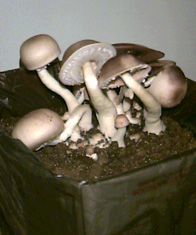
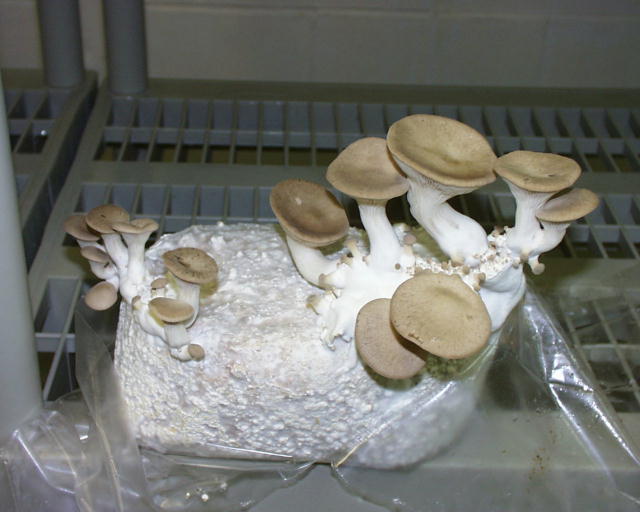
King Oyster mushrooms (Pleurotus eryngii) grown by the peroxide method at White Rock Creek Mushrooms in Hillsboro, Texas. Photo courtesy of Joe Durham.
Every mushroom species I have tested can be grown in the presence of peroxide, and it is highly likely that any mushrooms that otherwise can be cultivated can be grown this way. I personally have used peroxide successfully to keep agar cultures and prepare spawn of Pleurotus ostreatus (oyster), Pleurotus eryngii (King Oyster), Agaricus subrufescens (almond mushroom), Hypsizygus ulmarius (white elm mushroom or elm oyster), Hypsizygus tessulatus (shimeji), Coprinus comatus (shaggy mane), Lentinula edodes (shiitake), Hericium erinaceus (Lions' Mane), and Grifola frondosa (maitake). Others have used peroxide to grow Psilocybe species (in countries where it is legal to do so), Reishi (Ganoderma lucidum) and morel mycelium.The mushroom species I have grown most often are H. erinaceus, H. ulmarius, P. eryngii, and A. subrufescens. Each has different characteristics and requirements. I am not a shiitake grower, but others have used the method to grow shiitake successfully. Agaricus species such as crimini, white button mushrooms, Portabellos, the almond mushroom, and the almond portabello (Agaricus blazei) can all be grown with the help of peroxide for agar culture and spawn making. There is little practical use for peroxide in the production of compost, the favored substrate for these species, but straw can be readily prepared with the help of peroxide, and some may find it acceptable as an alternative to compost in Agaricus cultivation.
There is some question as to the effect peroxide oxidation may have on the mushroom substrate itself. Chlorine, when it reacts with organic materials like paper pulp, produces small amounts of dioxin, a very dangerous, cancer-causing chemical. Hydrogen peroxide does not produce dioxin, and as a result, environmentalists are campaigning to get paper companies to bleach their paper fiber with peroxide rather than chlorine. Still, it is conceivable that peroxide could produce some other harmful substance when it reacts with the organic materials in mushroom substrates. I have not ruled out this possibility, but I consider it unlikely. For one thing, living organisms have evolved for millions of years with hydrogen peroxide both in and around them. This means that aerobic organisms most likely have developed metabolic machinery to deal safely with the oxidation products that result from the reaction of peroxide with biological materials. In addition, hydrogen peroxide is chemically quite stable in sterilized mushroom substrates, and the concentration of peroxide we're using is so low that the amount of substrate oxidation going on has to be very low indeed. Finally, I have seen absolutely no evidence of any mutagenic or toxic effect of peroxide-treated mushroom substrate on the mycelium or fruiting bodies. Agar cultures containing hydrogen peroxide give fine, healthy halos of mycelium, and the final fruiting cultures produce mushrooms as beautiful as any grown by traditional methods.
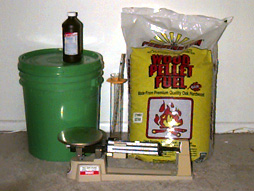
Preparing and handling bulk pellet fuel substrate by the methods described in the peroxide manual requires a covered pot for boiling and cooling water, a second pot such as a teapot to boil water for pasteurizing containers, and a larger container such as a five gallon plastic bucket with a tight-fitting lid.
If you are just a beginner at mushroom growing, whether or not you use the peroxide method, you will probably want a pressure cooker for making agar plates (although they can be made, less reliably, without it), jars with lids, an alcohol lamp, a small scale or balance for weighing, some petri dishes, some small boxes, some fresh trash bags, a hand mister, and a cool space. Later you may want a fan and an automatic misting system.
For some suggestions on obtaining the supplies used in the peroxide manual if you live in the US or the UK, visit my Sources page.
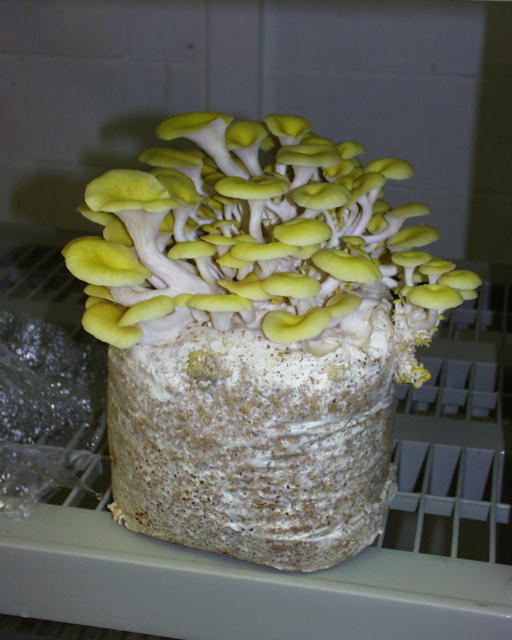
Golden Trumpet mushrooms grown by the peroxide method at White Rock Creek Mushrooms in Hillsboro, Texas. Photo courtesy of Joe Durham.
Yes. Volume II of the peroxide manual presents two peroxide methods for preparing bulk mushroom substrate in any quantity at room temperature. These methods are well suited to commercial cultivation. Both volumes of the manual present peroxide methods for maintaining tissue cultures, storing strains, and preparing mushroom spawn, all crucial aspects of commercial cultivation as well.For a video clip of the peroxide method in action at a commercial mushroom-growing operation in Mexico, go here.
All told, my blocks cost about $0.33 each, including pellet fuel ($0.14), lime ($0.01), supplements ($0.06), peroxide ($0.05), my own spawn ($0.02), bags ($0.04), and energy use ($0.01?). This compares to estimates I have seen ranging from $1.25 to $2.50 per block for shiitake cultivation with traditional methods (for example, Albert Bates of Mushroom People wrote an article on shiitake production for the Fungus Digest--now defunct--that estimated $2.50 per block). Perhaps some of this difference should be balanced against the experimental nature of the peroxide substrates, which may take time to optimize for yields comparable to traditional substrates. But this in turn should be balanced against the reduced contamination rate that can be expected using peroxide, even when compared to commercial set-ups using expensive contamination control systems.
This document is Copyright: ©2000 by Randall R. Wayne, Ph.D. All commercial rights are reserved. No part of this work may be reproduced or used for sale in any form or by any means without permission of the author.